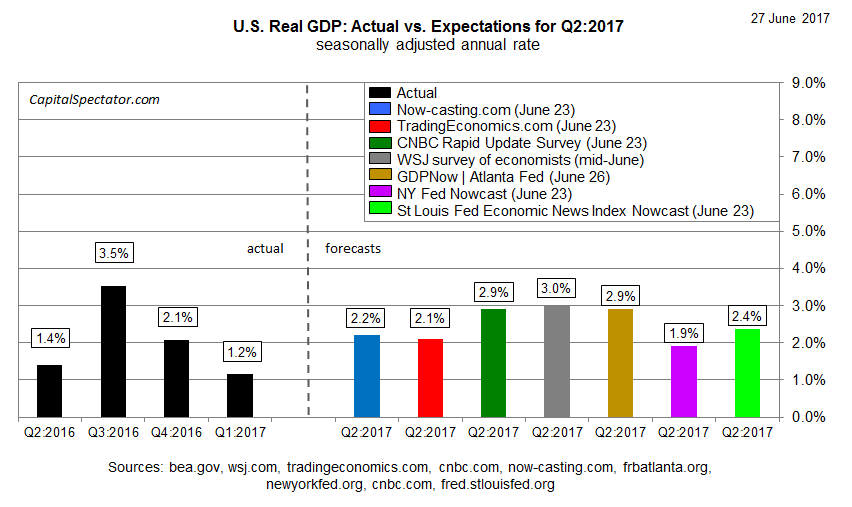Most estimates of second-quarter GDP growth continue to project an acceleration in economic activity following Q1’s sluggish rise. But weaker-than-expected numbers in yesterday’s data releases may be a sign that analysts will trim expectations for Q2’s rebound.
Durable goods orders in May fell by a deeper-than-forecast 1.1%, the Commerce Department reported on Monday. The drop marked the second consecutive monthly setback. Meanwhile, the Chicago Fed National Activity Index’s monthly print fell to its lowest reading since January.
It’s unclear if yesterday’s numbers will weigh on revised Q2 GDP estimates in the days ahead, although at least one projection remains unaffected. The Atlanta Fed’s GDPNow model remained unchanged at 2.9% (as of June 26) in the wake of yesterday’s update of durable goods orders. The Fed bank’s revised projection for Q2 still represents a healthy improvement over the weak 1.2% increase in Q1.

Meantime, IHS Markit on Friday reported that “the economy ended the second quarter on a softer note,” based on survey data published by the firm. “The June PMI surveys showed some pay-back after a strong May, indicating the second-weakest expansion of business activity since last September.”
Using the US Composite PMI as a guide, the consultancy advised estimated the economy is growing at a 0.4% quarterly rate (1.5% annualized) in Q2, “or just over 2% once allowance is made for residual seasonality in the official GDP data.” In addition, the PMI survey points to non-farm payroll growth of roughly 170,000, a moderate pace that’s slightly above the monthly average reported for the year so far through May.
The weaker-than-expected readings in yesterday’s data may be a reason to trim expectations a bit, but for the moment it’s still reasonable to assume that Q2 GDP growth will pick up in the government’s report that’s due out at the end of next month. Projecting a strong rebound of 3% or more looks slightly challenged, but a 2% rise still looks reasonable.
That’s a slow pace relative to economic growth in the US in recent decades, but demographics suggest that the macro trend has downshifted. If so, a 2%-plus rate for GDP may be the new normal for the foreseeable future. For perspective, note that GDP growth has averaged 2.1% since the Great Recession ended in mid-2009. By contrast, GDP growth averaged 3.1% for the 20 years through the end of 2007, just before the last recession started (based on seasonally adjusted real annualized rates).
In any case, recession risk remains low at the moment and yesterday’s releases don’t offer any reason to think otherwise. Although durable goods orders has been weak in the past two months, this is a volatile dataset. To smooth out the noise, consider the year-over-year change, which perked up to a modest 2.7% increase through May – the fourth straight annual increase.
Meantime, the 3-month average of the Chicago Fed National Activity Index – a more reliable measure for business-cycle analysis vs. the index’s monthly data – is still reflecting an above-average growth trend relative to history. Although the 3-month average dipped to +0.04 in May, that’s still far above the -0.70 tipping point that marks the start of recession.
Overall, it’s fair to say that slow-to-moderate growth remains a reasonable guesstimate for the near-term future. That’s not written in stone, of course. But until or if the incoming data tell us otherwise, the US economy still looks poised to expand, albeit at a mediocre rate compared with history.
